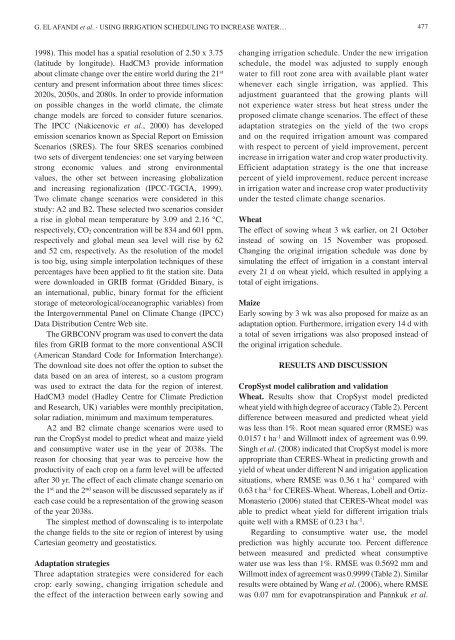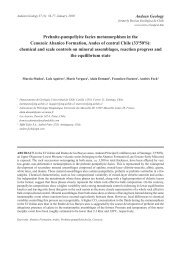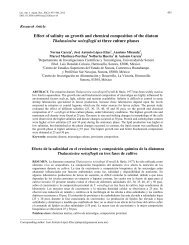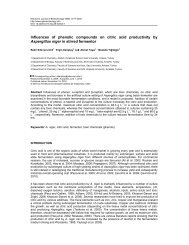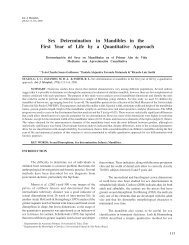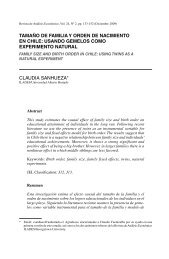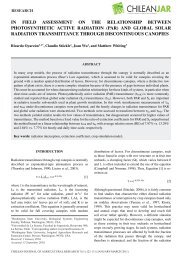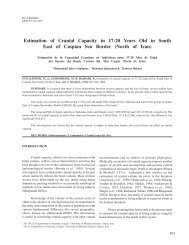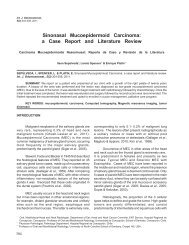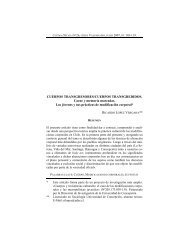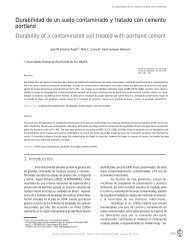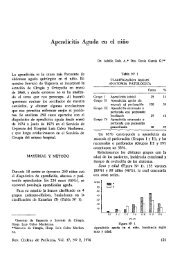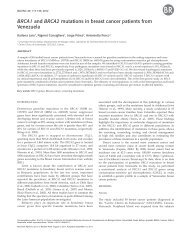using irrigation scheduling to increase water productivity of wheat ...
using irrigation scheduling to increase water productivity of wheat ...
using irrigation scheduling to increase water productivity of wheat ...
You also want an ePaper? Increase the reach of your titles
YUMPU automatically turns print PDFs into web optimized ePapers that Google loves.
G. EL AFANDI et al. - USING IRRIGATION SCHEDULING TO INCREASE WATER…<br />
477<br />
1998). This model has a spatial resolution <strong>of</strong> 2.50 x 3.75<br />
(latitude by longitude). HadCM3 provide information<br />
about climate change over the entire world during the 21 st<br />
century and present information about three times slices:<br />
2020s, 2050s, and 2080s. In order <strong>to</strong> provide information<br />
on possible changes in the world climate, the climate<br />
change models are forced <strong>to</strong> consider future scenarios.<br />
The IPCC (Nakicenovic et al., 2000) has developed<br />
emission scenarios known as Special Report on Emission<br />
Scenarios (SRES). The four SRES scenarios combined<br />
two sets <strong>of</strong> divergent tendencies: one set varying between<br />
strong economic values and strong environmental<br />
values, the other set between increasing globalization<br />
and increasing regionalization (IPCC-TGCIA, 1999).<br />
Two climate change scenarios were considered in this<br />
study: A2 and B2. These selected two scenarios consider<br />
a rise in global mean temperature by 3.09 and 2.16 °C,<br />
respectively, CO 2 concentration will be 834 and 601 ppm,<br />
respectively and global mean sea level will rise by 62<br />
and 52 cm, respectively. As the resolution <strong>of</strong> the model<br />
is <strong>to</strong>o big, <strong>using</strong> simple interpolation techniques <strong>of</strong> these<br />
percentages have been applied <strong>to</strong> fit the station site. Data<br />
were downloaded in GRIB format (Gridded Binary, is<br />
an international, public, binary format for the efficient<br />
s<strong>to</strong>rage <strong>of</strong> meteorological/oceanographic variables) from<br />
the Intergovernmental Panel on Climate Change (IPCC)<br />
Data Distribution Centre Web site.<br />
The GRBCONV program was used <strong>to</strong> convert the data<br />
files from GRIB format <strong>to</strong> the more conventional ASCII<br />
(American Standard Code for Information Interchange).<br />
The download site does not <strong>of</strong>fer the option <strong>to</strong> subset the<br />
data based on an area <strong>of</strong> interest, so a cus<strong>to</strong>m program<br />
was used <strong>to</strong> extract the data for the region <strong>of</strong> interest.<br />
HadCM3 model (Hadley Centre for Climate Prediction<br />
and Research, UK) variables were monthly precipitation,<br />
solar radiation, minimum and maximum temperatures.<br />
A2 and B2 climate change scenarios were used <strong>to</strong><br />
run the CropSyst model <strong>to</strong> predict <strong>wheat</strong> and maize yield<br />
and consumptive <strong>water</strong> use in the year <strong>of</strong> 2038s. The<br />
reason for choosing that year was <strong>to</strong> perceive how the<br />
<strong>productivity</strong> <strong>of</strong> each crop on a farm level will be affected<br />
after 30 yr. The effect <strong>of</strong> each climate change scenario on<br />
the 1 st and the 2 nd season will be discussed separately as if<br />
each case could be a representation <strong>of</strong> the growing season<br />
<strong>of</strong> the year 2038s.<br />
The simplest method <strong>of</strong> downscaling is <strong>to</strong> interpolate<br />
the change fields <strong>to</strong> the site or region <strong>of</strong> interest by <strong>using</strong><br />
Cartesian geometry and geostatistics.<br />
Adaptation strategies<br />
Three adaptation strategies were considered for each<br />
crop: early sowing, changing <strong>irrigation</strong> schedule and<br />
the effect <strong>of</strong> the interaction between early sowing and<br />
changing <strong>irrigation</strong> schedule. Under the new <strong>irrigation</strong><br />
schedule, the model was adjusted <strong>to</strong> supply enough<br />
<strong>water</strong> <strong>to</strong> fill root zone area with available plant <strong>water</strong><br />
whenever each single <strong>irrigation</strong>, was applied. This<br />
adjustment guaranteed that the growing plants will<br />
not experience <strong>water</strong> stress but heat stress under the<br />
proposed climate change scenarios. The effect <strong>of</strong> these<br />
adaptation strategies on the yield <strong>of</strong> the two crops<br />
and on the required <strong>irrigation</strong> amount was compared<br />
with respect <strong>to</strong> percent <strong>of</strong> yield improvement, percent<br />
<strong>increase</strong> in <strong>irrigation</strong> <strong>water</strong> and crop <strong>water</strong> <strong>productivity</strong>.<br />
Efficient adaptation strategy is the one that <strong>increase</strong><br />
percent <strong>of</strong> yield improvement, reduce percent <strong>increase</strong><br />
in <strong>irrigation</strong> <strong>water</strong> and <strong>increase</strong> crop <strong>water</strong> <strong>productivity</strong><br />
under the tested climate change scenarios.<br />
Wheat<br />
The effect <strong>of</strong> sowing <strong>wheat</strong> 3 wk earlier, on 21 Oc<strong>to</strong>ber<br />
instead <strong>of</strong> sowing on 15 November was proposed.<br />
Changing the original <strong>irrigation</strong> schedule was done by<br />
simulating the effect <strong>of</strong> <strong>irrigation</strong> in a constant interval<br />
every 21 d on <strong>wheat</strong> yield, which resulted in applying a<br />
<strong>to</strong>tal <strong>of</strong> eight <strong>irrigation</strong>s.<br />
Maize<br />
Early sowing by 3 wk was also proposed for maize as an<br />
adaptation option. Furthermore, <strong>irrigation</strong> every 14 d with<br />
a <strong>to</strong>tal <strong>of</strong> seven <strong>irrigation</strong>s was also proposed instead <strong>of</strong><br />
the original <strong>irrigation</strong> schedule.<br />
RESULTS AND DISCUSSION<br />
CropSyst model calibration and validation<br />
Wheat. Results show that CropSyst model predicted<br />
<strong>wheat</strong> yield with high degree <strong>of</strong> accuracy (Table 2). Percent<br />
difference between measured and predicted <strong>wheat</strong> yield<br />
was less than 1%. Root mean squared error (RMSE) was<br />
0.0157 t ha -1 and Willmott index <strong>of</strong> agreement was 0.99.<br />
Singh et al. (2008) indicated that CropSyst model is more<br />
appropriate than CERES-Wheat in predicting growth and<br />
yield <strong>of</strong> <strong>wheat</strong> under different N and <strong>irrigation</strong> application<br />
situations, where RMSE was 0.36 t ha -1 compared with<br />
0.63 t ha -1 for CERES-Wheat. Whereas, Lobell and Ortiz-<br />
Monasterio (2006) stated that CERES-Wheat model was<br />
able <strong>to</strong> predict <strong>wheat</strong> yield for different <strong>irrigation</strong> trials<br />
quite well with a RMSE <strong>of</strong> 0.23 t ha -1 .<br />
Regarding <strong>to</strong> consumptive <strong>water</strong> use, the model<br />
prediction was highly accurate <strong>to</strong>o. Percent difference<br />
between measured and predicted <strong>wheat</strong> consumptive<br />
<strong>water</strong> use was less than 1%. RMSE was 0.5692 mm and<br />
Willmott index <strong>of</strong> agreement was 0.9999 (Table 2). Similar<br />
results were obtained by Wang et al. (2006), where RMSE<br />
was 0.07 mm for evapotranspiration and Pannkuk et al.


